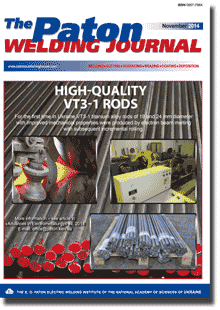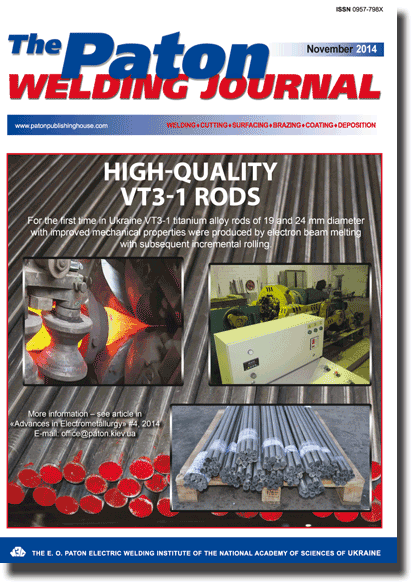| 2014 №11 (01) |
DOI of Article 10.15407/tpwj2014.11.02 |
2014 №11 (03) |

The Paton Welding Journal, 2014, #11, 8-14 pages
REDISTRIBUTION OF RESIDUAL WELDING STRESSES IN IN-VESSEL CORE BARREL OF WWER-1000 REACTOR DURING OPERATION
O.V. MAKHNENKO, E.A. VELIKOIVANENKO and I.V. MIRZOV
E.O. Paton Electric Welding Institute, NASU. 11 Bozhenko Str., 03680, Kiev, Ukraine. E-mail: office@paton.kiev.ua
Abstract
Reactor baffle is subjected to high radiation doses that results in its swelling and change of form in operation. Inside pressure of baffle on core barrel creates additional stresses in zone of contact. Residual welding stresses can also significantly effect a level of stressed state of core barrel wall, that should be considered in estimation of working capacity of vessel internals for extension of WWER-1000 reactor service life. Thus, a relevant task is an estimation of stressed state of in-vessel core barrel in area of its contact with baffle, in particular, when place of contact coincides with welded joint zone. Aim of present work is an investigation of stressed state in zone of welds of in-vessel core barrel of WWER-1000 reactor during operation considering radiation swelling and contact interaction of baffle and core barrel. A problem was solved by 2D finite element method using current mathematical models of radiation swelling and change of mechanical properties of 08Kh18N10T steel. Calculations show that effect of only temperature deformation does not promote high stresses in the core barrel wall, but degree of stress redistribution in it due to radiation swelling depends on residual welding stresses. Circumferential and axial stresses, caused by contact interaction of core barrel with baffle, have the largest impact on stressed state of the in-vessel core barrel wall in course of 60 years of operation. Stresses in the in-vessel core barrel welds at the end of extended operation period (60 years) are close to the values of yield strength of irradiated material. Residual welding stresses can significantly effect the level of stressed state of the core barrel wall, that should be considered in estimation of working capacity of vessel internals at extension of service life of WWER-1000 reactor. 4 Ref., 2 Tables, 11 Figures.
Keywords: in-vessel core barrel, WWER-1000 reactor, vessel internals, residual welding stresses, irradiation, 08Kh18N10T steel, life extension
Received: 13.02.14
Published: 28.11.14
References
1. Makhnenko, O.V., Mirzov, I.V. (2013) Investigation of stress-strain state of welded structures from austenitic steel at radioactive irradiation. The Paton Welding J., 1, 5-10.
2. Makhnenko, V.I., Makhnenko, O.V., Kozlitina, S.S. et al. (2012) Welded structures from austenitic steel of 10Kh18N10T type under conditions of radiation-induced swelling. Ibid., 2, 6-10.
3. Sorokin, A.A., Margolin, B.Z., Kursevich, I.P. et al. (2011) Influence of neutron irradiation on mechanical properties of materials of in-vessel internals of WWER type reactors. Voprosy Materialovedeniya, 2, 131-151.
4. Margolin, B.Z., Murashova, A.I., Neustroev, V.S. (2012) Analysis of influence of strained state type on radiation swelling and radiation creep of austenitic steels. Problemy Prochnosti, 3, 5-24.
Suggested Citation
O.V. Makhnenko, E.A. Velikoivanenko And I.V. Mirzov (2014) Redistribution of residual welding stresses in in-vessel core barrel of WWER-1000 reactor during operation. The Paton Welding J., 11, 8-14.The cost of subscription/purchase order journals or individual articles
| Journal/Currency | Annual Set | 1 issue printed |
1 issue |
one article |
| TPWJ/USD | 384 $ | 32 $ | 26 $ | 13 $ |
| TPWJ/EUR | 348 € | 29 € | 24 € | 12 € |
| TPWJ/UAH | 7200 UAH | 600 UAH | 600 UAH | 280 UAH |
| AS/UAH | 1800 UAH | 300 UAH | 300 UAH | 150 UAH |
| AS/USD | 192 $ | 32 $ | 26 $ | 13 $ |
| AS/EUR | 180 € | 30 € | 25 € | 12 € |
| SEM/UAH | 1200 UAH | 300 UAH | 300 UAH | 150 UAH |
| SEM/USD | 128 $ | 32 $ | 26 $ | 13 $ |
| SEM/EUR | 120 € | 30 € | 25 € | 12 € |
| TDNK/UAH | 1200 UAH | 300 UAH | 300 UAH | 150 UAH |
| TDNK/USD | 128 $ | 32 $ | 26 $ | 13 $ |
| TDNK/EUR | 120 € | 30 € | 25 € | 15 € |
AS = «Automatic Welding» - 6 issues per year;
TPWJ = «PATON WELDING JOURNAL» - 12 issues per year;
SEM = «Electrometallurgy Today» - 4 issues per year;
TDNK = «Technical Diagnostics and Non-Destructive Testing» - 4 issues per year.


